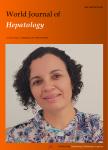Predictors for advanced fibrosis in morbidly obese nonalcoholic fatty liver patients
Predictors for advanced fibrosis in morbidly obese nonalcoholic fatty liver patients作者机构:School of Public HealthUniversity of Haifa Department of Gastroenterology Tel Aviv Medical Center Obesity Service Department of Gastroenterology Tel Aviv Medical Center the Sackler Faculty of Medicine Tel-Aviv University Bariatric Unit Department of Surgery Tel Aviv Medical Center
出 版 物:《World Journal of Hepatology》 (世界肝病学杂志(英文版)(电子版))
年 卷 期:2017年第9卷第2期
页 面:91-98页
学科分类:1002[医学-临床医学] 100201[医学-内科学(含:心血管病、血液病、呼吸系病、消化系病、内分泌与代谢病、肾病、风湿病、传染病)] 10[医学]
主 题:Non-alcoholic fatty liver disease Morbid obesity Fibrosis Fibroscan Diet
摘 要:AIMTo investigate predictors for fibrosis specifically in a high risk population of morbidly obese patients, including detailed evaluation of lifestyle. METHODSWe conducted a cross-sectional study among morbidly obese patients attending the bariatric clinic at the Tel-Aviv Medical Center between the years 2013-2014 with body mass index (BMI) above 40 or above 35 with co-morbidity. Patients with serum hepatitis B surface antigen or anti-hepatitis C virus antibodies, genetic liver diseases, autoimmune disease or high alcohol intake (≥ 30 g/d in men or ≥ 20 g/d in women) were excluded from the study. Liver fibrosis was estimated by transient elastography (FibroScan®), using the ‘‘XL’’ probe. We collected data on age and gender, education, smoking status and amount, medical history, nutrition and lifestyle habits. All these data were collected using structured and validated questionnaires. Fasting blood test were available for a subsample. RESULTSFibroscan was performed on a total of 91 patients, of which 77 had a valid examination according to the accepted criteria. Of those, 21% had significant fibrosis (F2) and 39% had advanced or severe fibrosis (F3 or F4). In multivariate analysis, male gender and BMI had a positive association with advanced fibrosis; the OR for fibrosis F ≥ 2 was 7.93 (95%CI: 2.36-26.64, P = 0.001) for male gender and 1.33 (1.11-1.60 kg/m2, P = 0.002) for BMI. The OR for fibrosis F ≥ 3 was 2.92 (1.08-7.91, P = 0.035) for male gender and 1.17 (1.03-1.33, P = 0.018) for BMI. Subjects were categorized to subgroups based on the combination of male gender and BMI of 40 and above. A significant dose response association with stiffness level was noted across these categories, with the highest stiffness among men with a higher BMI (P = 0.001). In addition, a significant positive correlation between pack-years cigarette smoking and liver stiffness was demonstrated among men (r = 0.54, P = 0.012)



